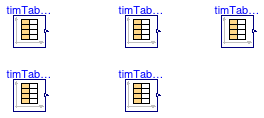CDL.Continuous.Sources.Validation
Collection of models that validate the continuous sources blocks of the CDL
Information
This package contains models that validate the blocks in CDL.Continuous.Sources.
The examples plot various outputs, which have been verified against analytical solutions. These model outputs are stored as reference data to allow continuous validation whenever models in the library change.
Package Content
| Name | Description |
|---|---|
| Validation model for the calendar time model | |
| Validation model for the calendar time model with start time slightly below the full hour | |
| Validation model for the calendar time model with start time slightly higher than the full hour | |
| Validate the Constant block | |
| Validation model for the Pulse block | |
| Validation model for the Ramp | |
| Validation model for Sin | |
| Test model for the StandardTime block | |
| Validation model for TimeTable block | |
| Validation model for TimeTable block with negative start time |
 CDL.Continuous.Sources.Validation.CalendarTimeMonths
CDL.Continuous.Sources.Validation.CalendarTimeMonths
Validation model for the calendar time model

Information
This model validates the use of the CDL.Continuous.Sources.CalendarTime block for a period of a couple of months. This shorter simulation time has been selected to store the reference results that are used in the regression tests at a resulation that makes sense for the minute and hour outputs.
Modelica definition
 CDL.Continuous.Sources.Validation.CalendarTimeMonthsMinus
CDL.Continuous.Sources.Validation.CalendarTimeMonthsMinus
Validation model for the calendar time model with start time slightly below the full hour

Information
This model validates the use of the CDL.Continuous.Sources.CalendarTime. It is identical to CDL.Continuous.Sources.Validation.CalendarTimeMonths except that the start and end time are different.
Extends from CDL.Continuous.Sources.Validation.CalendarTimeMonths (Validation model for the calendar time model).
Modelica definition
 CDL.Continuous.Sources.Validation.CalendarTimeMonthsPlus
CDL.Continuous.Sources.Validation.CalendarTimeMonthsPlus
Validation model for the calendar time model with start time slightly higher than the full hour

Information
This model validates the use of the CDL.Continuous.Sources.CalendarTime. It is identical to CDL.Continuous.Sources.Validation.CalendarTimeMonths except that the start and end time are different.
Extends from CDL.Continuous.Sources.Validation.CalendarTimeMonths (Validation model for the calendar time model).
Modelica definition
 CDL.Continuous.Sources.Validation.Constant
CDL.Continuous.Sources.Validation.Constant
Validate the Constant block

Information
Validation test for the block CDL.Continuous.Sources.Constant.
Modelica definition
 CDL.Continuous.Sources.Validation.Pulse
CDL.Continuous.Sources.Validation.Pulse
Validation model for the Pulse block

Information
Validation test for the block CDL.Continuous.Sources.Pulse.
Modelica definition
 CDL.Continuous.Sources.Validation.Ramp
CDL.Continuous.Sources.Validation.Ramp
Validation model for the Ramp

Information
Validation test for the block CDL.Continuous.Sources.Ramp.
Modelica definition
 CDL.Continuous.Sources.Validation.Sin
CDL.Continuous.Sources.Validation.Sin
Validation model for Sin

Information
Validation test for the block CDL.Continuous.Sources.Ramp.
Modelica definition
 CDL.Continuous.Sources.Validation.StandardTime
CDL.Continuous.Sources.Validation.StandardTime
Test model for the StandardTime block

Information
This model tests the implementation of the block that outputs the model time.
Modelica definition
 CDL.Continuous.Sources.Validation.TimeTable
CDL.Continuous.Sources.Validation.TimeTable
Validation model for TimeTable block

Information
This model validates the TimeTable block. It takes as a parameter a time table of the format
table = [ 0*3600, 0;
6*3600, 1;
18*3600, 0.5;
24*3600, 0];
The block timTabLin applies smoothness method of linear segments
between table points, periodically repeat the table scope.
The block timTabLinHol applies smoothness method of linear segments
between table points, hold the last table points when it becomes outside of
table scope.
The block timTabLinDer applies smoothness method of linear segments
between table points, extrapolate by using the derivative at the last table
points to find points outside the table scope.
The block timTabCon applies smoothness method of constant segments
between table points, periodically repeat the table scope.
The block timTabLinCon applies smoothness method of linear segments
between table points, periodically repeat the table scope. Table points is
different so to ensure constant zero during time range of
(0*3600, 6*36000).
table = [ 0*3600, 0;
6*3600, 0;
6*3600, 1;
18*3600, 0.5;
24*3600, 0];
Modelica definition
 CDL.Continuous.Sources.Validation.TimeTableNegativeStartTime
CDL.Continuous.Sources.Validation.TimeTableNegativeStartTime
Validation model for TimeTable block with negative start time

Information
This model validates the block CDL.Continuous.Sources.TimeTable. The model is identical to CDL.Continuous.Sources.Validation.TimeTable except that the start time is negative, and not a multiple of a full day.
